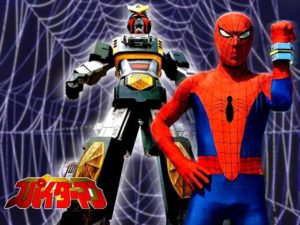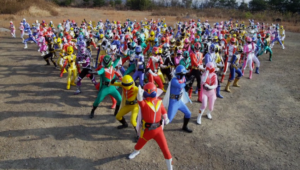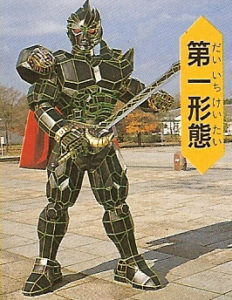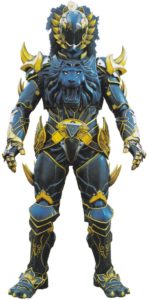This guest editorial is written by Adam R. (@liladam87 on Twitter). Our sincerest thanks to him for reaching out about writing this piece. We hope you enjoy – let him know if you do!
2018 was a truly transformative year for Power Rangers: it both celebrated its 25th anniversary and became acquired by toy industry giant Hasbro. Baby steps, right? Despite the brand’s endurance and the iconic status of its earlier seasons, you’ll often hear people referring to Power Rangers in the same way as they would music from their youth: “I liked the earlier stuff but haven’t kept up.” I’ve been hearing this increasingly since the Hasbro bombshell. There has never been a better opportunity to highlight why this new era of the Power Rangers franchise is just as exciting as anything currently occurring in other beloved superhero brands such as Marvel or DC. Before we delve into that, we need to explore its history and appeal.
Some of the same people who made Marvel a mainstream success were those who made Power Rangers a reality, namely Stan Lee and Margaret Loesch. These two trendsetters saw the colorful, fun, action-packed Japanese superhero show Super Sentai and believed it could be adored in the United States. That’s right: the legendary co-creator of many beloved Marvel superheroes had been the first to try and adapt Super Sentai for US audiences. Something about the bombastic flavor of the original TV show enamored Stan. Just like his most famous creation Spider-Man, virtually every single Super Sentai hero is covered head-to-toe in costume and a majority are in their late teens or early 20’s. They also struggle to balance issues in their civilian lives while constantly fighting the forces of evil.
Marvel had previously produced live-action superhero shows in the US but wanted to expand their reach. To that end, Marvel Productions and Super Sentai’s parent company Toei struck an agreement whereby each company would share the rights for different interpretations of their characters. While Marvel could subtitle and distribute Toei’s shows in the United States, Toei’s Spider-Man featured the wall-crawler fighting the Iron Cross Army with the help of his giant robot Leopardon over in Japan. Stan then worked with Marvel Productions CEO Margaret Loesch to sell a dubbed version of Taiyo Sentai Sun Vulcan (a season of Super Sentai that Marvel had a hand in financing) to various US networks such as HBO. They all passed on it. The networks saw it as cheesy, low-budget nonsense and nothing more. Eventually, Toei and Marvel’s agreement came to an end and it seemed as if Super Sentai would never reach an American audience.
As fate would have it, music producer and businessman Haim Saban happened to catch an episode of Super Sentai while in Japan. Just like Stan, Haim saw the potential for the show to succeed in the U.S. He shot his own English-language pilot of Super Sentai and showed it to several networks, but was met with the same resistance that Stan experienced a few years prior. It seemed that history was repeating itself once again, but one executive at Fox agreed to air his proposed show once she saw Haim’s pilot. That person? Margaret Loesch. The U.S. was finally on track to experience the phenomenon. 1
I can still vividly remember when Mighty Morphin Power Rangers first premiered on television. The thunderous heavy metal theme song with its catchy chorus filled me with searing anticipation unlike anything else I’d ever heard. The audience was introduced to five “teenagers with attitude” who wielded flashy Morphers, which were devices that changed the teens into their superhero form. As a kid, you could easily imagine yourself in any one of those suits after mimicking the mesmerizing morphing sequence. If that wasn’t enough, each Ranger also commanded a Zord: a gigantic robotic version of whichever beast was featured as the motif of their suit. Each zord would either erupt from the ground, bound across a jungle, speed across a desert, burst out of ice, or explode out of a volcano. This was completely captivating.
Finally, all the zords would combine into a colossal humanoid robot known as the Megazord. The use of models to film the scenes of the robots interlocking to form the Megazord appears as impressive today as it did more than 25 years ago. Within these zords, we see the legacy of the earlier deal between Marvel and Toei. The aforementioned Leopardon from Toei’s Spider-Man was the forerunner of the zords that are an integral feature in Super Sentai/Power Rangers. In between the action, each episode featured the teens tackling various issues in their lives while also featuring the hijinks of comedic duo Bulk & Skull to bring levity. With sharply designed superheroes, thrilling stunt work, striking monsters/aliens, imposing robots, and memorable music, Power Rangers is an impressive mix of sci-fi/fantasy influences. I had been reading similar stories in Marvel and DC comic books, but seeing it in live-action form put the show on another level. This is just one of the many reasons why it has continued to air.
Fellow Power Ranger fans unanimously agree that the themes of diversity, teamwork, inclusion, and self-affirmation continue to draw them to the franchise. From the beginning, Power Rangers has managed to showcase these attributes without being overbearing. They are integral components of the brand that flow naturally through its storytelling. Even though the franchise is seemingly aimed at young boys, the brand certainly counts young girls and women amongst its fans as well. The central message of working together as a team despite their differences allows a variety of characters to be featured on the show. This connects viewers of multiple backgrounds with characters that may closely resemble themselves. At the same time, with similarities to Spider-Man, any person can imagine themselves underneath the helmet of any Ranger. The possibilities are limitless and Power Rangers leverages those hallmarks to welcome all types of people.
Power Rangers suffers from the stigma that it exists solely to sell toys and is therefore “only for kids.” It’s important to remember that every pop culture brand largely exists to sell merchandise, whether it’s shirts, posters, coffee mugs, or toys. This criticism should not be levied solely against Power Rangers while Marvel, DC, Star Wars, Transformers, etc. get a pass. People who succumb to this mindset are missing out on some of the best comics that are currently on the market. I’ve been reading all types of comics for two decades. From Spider-Man to Saga to Strangers in Paradise, I’ve seen what the medium can achieve. Boom Studios’ Power Rangers comics have reinvigorated the brand by pushing back against the aforementioned “only for kids” stigma. Writers like Kyle Higgins and Ryan Parrott have crafted stories that focus on more complicated, nuanced themes. These stories are accompanied by stunning splash pages that would make the “Big Two” blush. Marvel did try their hand at publishing Power Ranger comics during the Mighty Morphin era, but most of it was created using the same mindset of those network executives who turned Stan and Margaret down rather than telling the best stories possible to captivate an audience. Unfortunately, many non-enthusiasts still view Power Rangers from this perspective today. However, they should instead note that the “only for kids” label that they’ve branded Power Rangers with is the same label that was foisted on their favorite characters and franchises before they became popular. While the 2017 Power Rangers movie didn’t light the box office on fire, those who did give it a chance despite its name had a common reaction: “That was surprisingly better than I expected.” If you’re just discovering Power Rangers in any form, you might get the same feeling.
Now, we explore the topic and reason you’re most likely reading this: toys. Since this is a superhero franchise, the designs of everything from the Ranger’s costumes to the arsenal at their disposal to the creatures they fight must be distinctive and attractive. Every year, Toei, Bandai of Japan, and PLEX create a new season of Super Sentai that fits a theme they believe will be embraced. People are enjoying Harry Potter? Here comes Mahou Sentai Magiranger (adapted as Power Ranger Mystic Force), a season based on magic. Minecraft is capturing the attention of young people? Enter Doubutsu Sentai Zyuohger, which prominently features cubed animals and weapons. They also revisit motifs that prove wildly popular. Even though there have previously been 3 dinosaur-themed seasons of Super Sentai, the newest installment is Kishiryu Sentai Ryusoulger: a season which features knights armed with dinosaur powers. There have been plenty of Rangers in Red, Blue, Pink, Yellow, etc., but the design of each Ranger and how they incorporate the overall elements of the theme is exciting on its own.
If you thought Infinity War had the most superheroes on screen…
Once the aesthetics of the heroes have been nailed down, the villains take their malevolent shape. The designers must not only create the primary antagonist, but they also produce generals, the grunts, and approximately 40 “Monsters of the Week” for our heroes to fight. Per season. When you take into consideration that this series of shows has been running for over 43 years in Japan and 25 years in the United States, it is an astoundingly impressive number of original designs with no other comparison in pop culture. Sure, they’re not all going to be winners (looking at you Turkey Jerk), but many of the monsters, aliens, and demons are singularly intriguing. Hasbro grabbed people’s attention with Lord Zedd and Goldar in the Lightning Collection, but wait until we get characters such as Ecliptor and Dai Shi (pictured below). Figures of these characters would fit perfectly into a diorama for Marvel Legends, Star Wars Black Series, and other 6 inch scale lines that are looking for some uniquely designed enemies for the heroes to combat. One of the best aspects of action figure collecting is that you can mix various brands together to form a personal display. Nobody should keep their Marvel figures separate from Transformers. Hell, you can team up Megazords and Transformers together to fight Power Ranger aliens and demons. With the quality of figures that Hasbro has unveiled thus far (from both their basic line and the Lightning Collection), the excitement from those outside of RangerNation is palpable.
There’s a word that has often been repeated by Hasbro CEO Brian Goldner when it comes to Power Rangers: potential. Mr. Goldner worked for Bandai of America back in the 90’s and saw it explode into a phenomenon firsthand. Its popularity had waned since those days, but the show kept going and produced seasons that were better than the original iteration. Hasbro’s purchase spearheaded by Goldner has captured the interest of many who haven’t paid attention to Power Rangers since they were youngsters. In recent years, the brand has expanded into previously unexplored areas by some of the most dedicated, hardworking creative people in their respective fields. Whether it’s the Boom Studios Comics or the Legacy Wars mobile game or the Hyperforce interactive table-top game, there has been a renewed inventive energy in Power Rangers. It has also led to unbeatable brand synergy that would make bigger properties jealous. The greater population may recognize and admire only the Mighty Morphin Power Rangers, but those Rangers that came after MMPR now have their time to shine. Potential is the correct choice word for describing Power Rangers’ future. It always had this latent vigor, ready to be unleashed. Hasbro is certainly delivering on this with their recently unveiled toylines and the latest season (named Beast Morphers). So dive in and experience what Morphin Time is all about. RangerNation is here to welcome you.
PS: Hasbro, if you happen to be reading this, I would love nothing more than Marvel Legends figures of Toei’s Spider-Man and Leopardon. Since you are the owners of Power Rangers and hold the master toy license for Marvel, it only makes complete sense to celebrate by take the progenitor of the Megazord and creating a figure of it. Thank you for your consideration!



